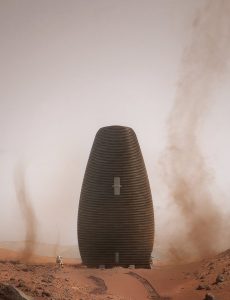
MARSHA (MARS HAbitat), features tall, cylindrical structures that resemble elongated eggs, optimized to handle internal atmospheric pressure and structural stresses. They’re quite different from Earth dwellings, which are designed to handle mostly gravity and wind.
The ground level of each MARSHA structure has a “garage” that contains external systems and exploration activities with a supporting wet lab. Above that is the main hub, with 34 square meters of joint dry lab and kitchen. The third level has individual cabins, a sanitation pod, and a hydroponic garden. The fourth level is a recreation and exercise area and features a bright, water-filled skylight. Each building is made from two “shells” with the space between acting as a light-well. Circadian lighting is designed to recreate Earthlight.
The reason so much work is being put into developing methods and materials for construction on Mars is that it isn’t realistic at all to consider bringing building materials from Earth, so everything must be fabricated from material readily available on the red planet. To that end, AI spaceFactory is developing basalt fibre-reinforced PLA (bf-PLA), with the basalt extracted from Mars rocks and the PLA harvested and processed from plants grown on Mars. Basalt fibre is super-strong and happens to be a natural insulator, so it’s convenient that it will be so readily available, as well.
“Architecture on Earth plays a critical role in the way we live. On Mars, this role reaches a higher level of importance since architectures are machines which keep us alive,” says AI spaceFactory. “In space architecture, every design decision is of great consequence to the success of a mission. Structures must be resilient and interior layouts must function around mission demands. But since sustained social and mental health is also mission-critical, space habitats should offer an element of humanity. The result is a credible and evocative habitat with an alien yet familiar beauty.”
The structures may look alien from the outside, but on the inside, they appear comfortable and livable. The fact that they’re built vertically means that there’s no need for a robot to travel across an unknown surface to build them; a stationary rover with a telescoping arm builds the structures.
NASA has awarded AI SpaceFactory almost $21,000 to further develop the project.
Discuss this and other 3D printing topics at 3DPrintBoard.com or share your thoughts below.
[Images: AI spaceFactory]